Denodo is the leader in data virtualization offering data governance, data access, and data delivery abilities throughout the wide varieties of cloud, enterprise, unstructured, and big data sources without transferring the data from their native repositories. We use Data Virtualization in everything from small projects that are in need of rapid data access, or as a part of a data warehousing project or more extensive application, to an enterprise-level semantic or general data layer.
Denodo tool is used in different industries like Banking, Finance, Social Media, Marketing, Entertainment, Big data, etc. The Data Virtualization Market is expected to reach $10.87billion by 2027. According to ziprecruiter.com, the average salary of a Virtualization engineer in the US is around $114K per annum. Thus, by learning the Denodo tool, you can build a promising career in the Data Virtualization field. If you want to master the Denodo platform, join our Denodo training. In this Denodo tutorial, we will discuss all the fundamental and vital concepts of the Denodo Platform.
Denodo Tutorial - Table Of Contents
- What is Denodo?
- Need of Denodo Platform
- Data Virtualization Basics
- 3 Cs Principles of Denodo
- Getting Started with Denodo Admin Tool
- Creating a Web Service
- Deploying the Web Service
- What’s New in Denodo?
- Denodo for AWS, Azure, and GCP
- What is Data Governance?
What is Denodo?
Denodo is the latest product of Denodo Technologies, Inc. It is a freeware data virtualization utility with the GUI(Graphical User Interface)-based studio. The Denodo Express integrates and connects unstructured, big data, and structured sources on-site and in the cloud. End-Users can access those resources, along with dashboards, enterprise apps, intranet, portals, other tools, etc.
Need of Denodo Platform
Denodo Platform provides advanced performance in logical data warehouses, big data, and operational strategies. It expedites adoption through cloud data virtualization. It simplifies business users’ data using self-service data searches and discovery.
Data Virtualization Basics
Why Data Virtualization?
Data Virtualization builds a single virtual layer that links diverse data and offers integrated access to the applications. These applications utilize the semantic components specified in the virtual layer and reuse them as required. In this method, our applications will be autonomous from physical sources to store the data. Denodo platform offers:
- Simple to create data services.
- Data Services are separate from the physical sources.
- The single point for controlling our data sources.
- Agile and Short development cycles.
- Instinctive solutions for simple requirements.
- Little or no coding.
- Reusing our models by all the clients.
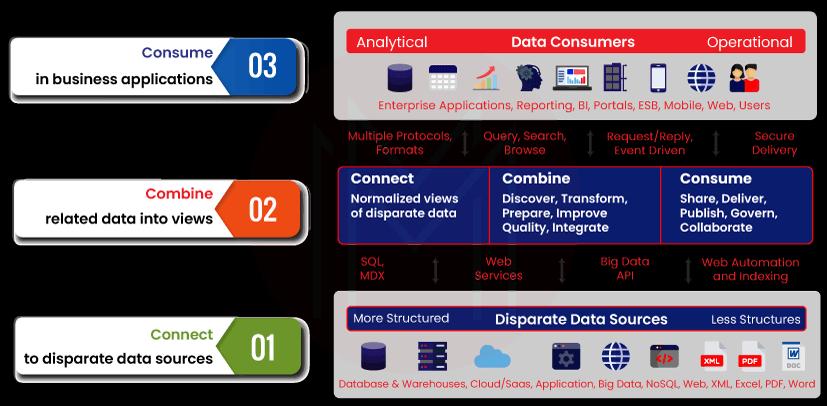
Bootstrapping & Installation - Pre-installation Needs
This section describes the preconditions to start utilizing the Denodo and guidelines to configure our Denodo environment and work with the data virtualization.
- Denodo Platform 8.0: Open “https://community.denodo.com/express/” and download the license and installer.
- Mysql 5.0: We will require MySQL for storing some of the data sources utilized in this tutorial.
- Denodo Tutorial Files: Extract and Download the compressed components into the traditional local directory, which can be referred to as <tutorial_directory>.
- MySQL Workbench: These are helpful tools we may use in MySQL.
- MySQL Connector: MySQL Connector is the JDBC Driver that enables Denodo to connect to MySQL.
Launching Denodo
Denodo is the global solution for dispersed and varied data source integration using the virtual approach. It can link to different data sources like web services, flat files, relational databases, JSON sources, XML documents, etc. Denodo will build the wrappers over the top of these data sources for creating a standard interface for accessing them. After that, a user combines the data from various data sources by specifying the views through Administrator Tool GUI.
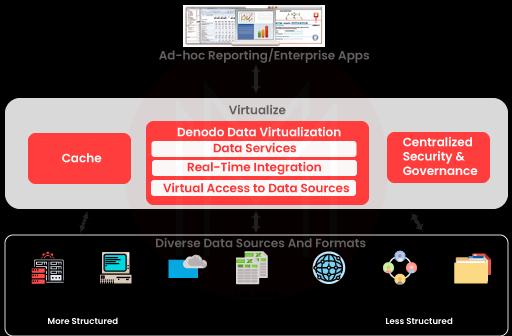
Step1: Press “Virtual DataPort” in the top-left.
Step2: Press the blue play button next to the Virtual DataPort for starting the Virtual DataPort server.
Step3: When the text before the play button indicates “Running,” start the “Virtual DataPort Administration Tool” by pressing the “LAUNCH” button.
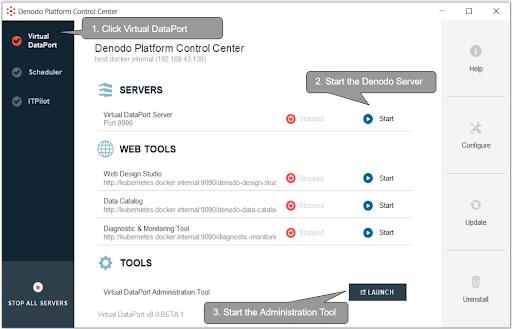
Denodo Installation
Step1: Install Denodo in a directory and name that directory as <DENODO_HOME>.
Step2: Import “MySQL-connector-java-.jar” into the “Virtual DataPort Administration Tool.” The Denodo platform does not contain the JDBC driver for the adapter. Therefore, upload the jar files of the driver through Admin Tool Wizard “File/Extension Management” and choose “MySQL-5” as the version.
Step3: Installing and Configuring the Database
- Install MySQL Server.
- Start MySQL and Launch MySQL Workbench application.
- Connect to our MySQL server and later open the “tutorial_directory>/MySQL/schema.sql” script by selecting “Open SQL Script” from File Menu.
- After opening the script, press “Execute.”
- After performing this, we must see a new database known as “acme_crm” with three tables.
Step4: Install the webserver
- Open the <tutorial_directory>/jetty, and run: “java -jar start.jar” from command line. If we do not have the java virtual machine installed on the system, we can utilize the JVM installed with the Denodo Platform in <DENODO_HOME> /JRE/bin.
- Testing the billing web service to see if it has been correctly deployed. Guide the web browser to “http://localhost:8080/billing/services” If successfully deployed, we will see the catalog of the existing services “AdminService,” “BillProvider,” and as well as their vulnerable methods and a choice for witnessing the WSDL descriptor.
The following screenshots demonstrate the Denodo 8.0 Installation:
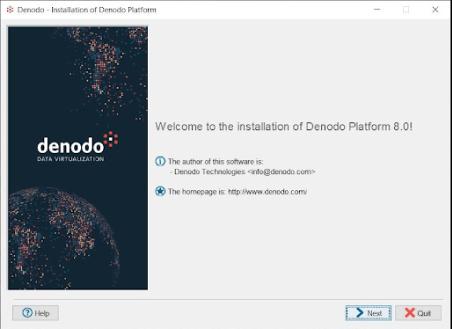
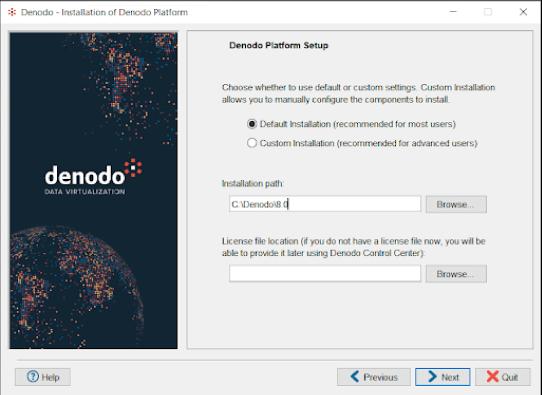
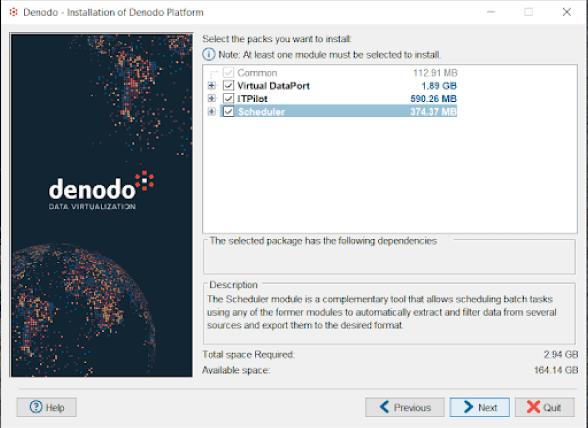
3 Cs Principles of Denodo
Data Virtualization is the layer that enables enterprises to integrate real-world data from multiple data sources and make it accessible to them without revealing any technical details. The approach of Denodo is based on “Three C’s Principle”:
- Connect: It connects any data source.
- Combine: As the objective of the data virtualization is to gather the data from various sources and integrate it to satisfy the business requirements, this layer is developed. A developer is anticipated to specify the data combination and transformation to fit the enterprise requirements in the layer.
- Consume: Lastly, a medium or method to make real-world data accessible to the data consumers. Denodo provides various options for the users for accessing the data, containing JDBC Drivers, Web Services(REST/SOAP), and ODBC Interface.
Getting Started with Denodo Admin Tool
The Denodo Administration tool enables the administration and development of our data visualization. Mainly, we can carry out the below tasks:
- Create/Drop/Edit the Denodo Virtual Databases.
- Create/Drop/Edit the Data Sources.
- Create/Drop/Edit the Views.
- Execute Queries.
- Publish Data Services.
- Configuring Cache System.
- Adding the Extensions.
- Configuring Denodo Server.
- Export/Import Metadata
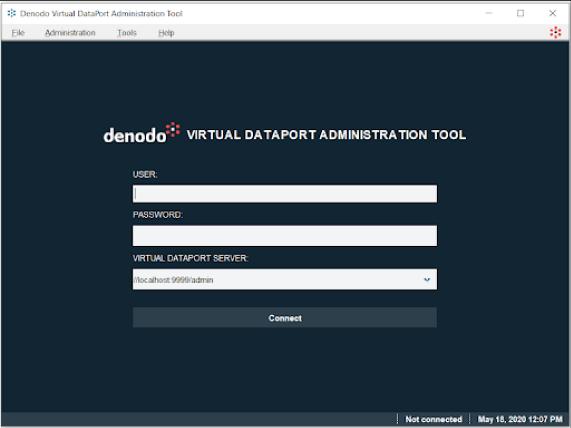
Following are the four primary areas of the Denodo Administration Tool:
Elements Tree: This area will display a tree with different components generated in the database.
Menu Bar: In the Menu Bar, we can see the options of all the sections of the Denodo Administration tool.
Workspace: It is the primary panel where the chosen element from the Opened Views and Elements Tree will be displayed.
Quick Search: This section filters particular elements in the elements tree.

Later, Open “Menu/Administration/Database Management/New to create a new database.”

Creating a Web Service
Follow these steps to create a SOAP web service in Denodo:
Step 1: We will utilize the Virtual DataPort Administration Tool to create SOAP Data Services. Go to the Administration tool and create the new folder known as SOAP in your two data-services folders.
Step 2: Right-click on the folder and choose “New/Data Service/SOAP Web Service.”

Step 3: This opens the “Create SOAP Web Services” Dialog. This dialog has the following tabs:
- Settings: It handles the configuration.
- Operations: In this section, we can define the catalog of web services functions.
- Advanced: In this tab, we can modify the connection parameters between Denodo Server and Web Service.
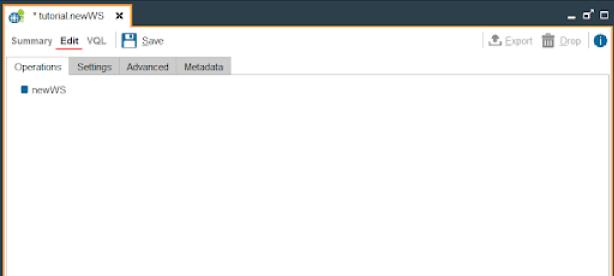
Step 4: Press “+ next” for the “i_client_info” and rename operation “getl_CLIENT_INFOByCLIENT_ID..” to: getClientById
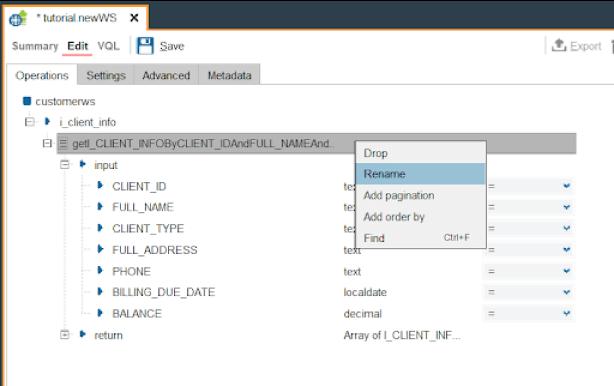
Step5: When we have to search the clients through ID, we must leave the input_parameter “client_id” and leave the rest. We can do that by right-clicking the other fields and choosing Drop.
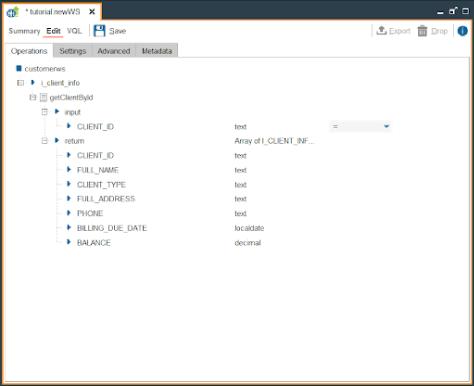
| Checkout Denodo Interview Questions |
Deploying the Web service
Deploying the web services by right-clicking them.
This will deploy the web service and deliver you the URL to access the web service.

What’s New in Denodo
Denodo’s determination to offer an integrated data delivery layer as the logical data fabric for bridging the gap between business and IT, concealing the inherent difficulty, and developing the semantic layer for revealing the data in an enterprise-friendly way. To achieve that determination, Denodo Platform 8.0 integrated features that speed up the delivery of secured data to enterprise applications. Denodo Platform 8.0 also offers capabilities to support new types of users and use cases. Following are some of the unique features of Denodo 8.0:
- Web-Based, Integrated, and Improved User Interface.
- Performance Speeding up for the problematic analytical queries in the Data Fabric Scenarios or Logical Data Warehouse.
- Improved Data Services APIs with the Graph-Like Access to the Denodo Views.
- PaaS Support for Hybrid and Cloud Environments.
- Improved User Experience in Data Catalog.
- Exceeding the Logical Data Warehouse: New Support for Machine Learning and Data Science.
Denodo for AWS, Azure, and GCP
Denodo on AWS
Denodo Platform on the AWS platform allows us to rapidly utilize the data virtualization with the cloud computing capabilities and streamline their migration to the cloud. It assists us in designing and implementing the hybrid cloud architecture that offers a data services layer throughout the cloud and on-site. Following are the different deployment and architectural best practices:
- Deployment on the AWS Cloud.
- Data Virtualization in Cloud.
Denodo for Azure
Denodo Platform 8 improves Denodo data virtualization for Azure with the latest integrated web-oriented user interface with sole sign-on, hyper-performance with ML, AI-powered data catalog improved intelligent query optimization and configuration settings, the Apache Zeppelin-oriented Denodo notebook, etc. Denodo Platform for Azure provides the same broad capabilities in on-site environments. Denodo Standard 8 delivers an efficient and easy option to start utilizing Denodo pay-as-you-go in the cloud marketplaces. Denodo has the below Microsoft Azure Services:
- Azure Synapse Analytics
- Azure SQL Database
- Azure Cosmos DB
- Azure HDInsight
- Azure Blob
- Azure Data Lake Storage Gen2
Denodo for GCP (Google Cloud Platform)
We can install Denodo on the GCP(Google Cloud Platform) as IaaS(Infrastructure as a Service) or through the GCP(Google Cloud Platform) Marketplace. While utilizing the GCP as the cloud infrastructure, we can install Denodo Platform through BYOL(Bring Your Own License).
In Denodo 8, Denodo has introduced the latest entry-level version of the Denodo data virtualization for the cloud marketplaces known as Denodo Standard. It offers cost-efficient options to work with Denodo in cloud marketplaces. The Denodo Platform supports different types of data sources on google cloud. We can utilize ODBC or JDBC for connecting to various data sources for integration purposes. Following are some vital data sources supported through connectors in the Denodo platform:
- Google Cloud Storage
- Google DataProc
- Google BigQuery
- Cloud Spanner
- Google Cloud SQL
- Cloud Bigtable
What is Data Governance?
Data Governance is a bunch of roles, processes, standards, metrics, and policies that assure the efficient and effective utilization of data in allowing the organization to accomplish its goals. It specifies how businesses handle usability, integrity, security, and availability with a group of prescribed processes and rules.
With the advancement of social media, big data, cloud, and web technologies, a vast amount of data is spread worldwide, both on-site and off-site. In the absence of appropriate control and visibility of our enterprise data, your organization cannot risk productivity loss and revenue but also confront the experiential crises. Particularly industries like pharmaceuticals and financial services are continuously under government scrutiny to ensure that the consumer data is protected and private.
Conclusion
Denodo is the data virtualization platform that offers specific capabilities like data access management, data security, and handling the cloud infrastructure of your enterprise. I hope this Denoto tutorial provides you with the required information about Data Virtualization and Denodo.
 On-Job Support Service
On-Job Support Service
Online Work Support for your on-job roles.

Our work-support plans provide precise options as per your project tasks. Whether you are a newbie or an experienced professional seeking assistance in completing project tasks, we are here with the following plans to meet your custom needs:
- Pay Per Hour
- Pay Per Week
- Monthly
| Name | Dates | |
|---|---|---|
| Denodo Training | Jan 10 to Jan 25 | View Details |
| Denodo Training | Jan 13 to Jan 28 | View Details |
| Denodo Training | Jan 17 to Feb 01 | View Details |
| Denodo Training | Jan 20 to Feb 04 | View Details |

Vinod Kasipuri is a seasoned expert in data analytics, holding a master's degree in the field. With a passion for sharing knowledge, he leverages his extensive expertise to craft enlightening articles. Vinod's insightful writings empower readers to delve into the world of data analytics, demystifying complex concepts and offering valuable insights. Through his articles, he invites users to embark on a journey of discovery, equipping them with the skills and knowledge to excel in the realm of data analysis. Reach Vinod at LinkedIn.
















